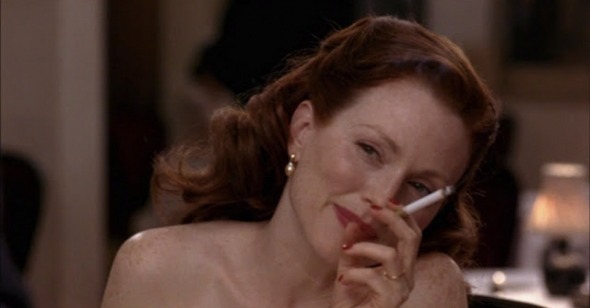Beyond the Pale
By Michael Koresky
Savage Grace
Dir. Tom Kalin, U.S., Strand Releasing
Tom Kalin’s 1992 film Swoon was a noteworthy entry in the New Queer Cinema canon not because of its subject matter but how Kalin navigated such precarious
terrain. A recouping of the Leopold and Loeb murder as an emotionally ambivalent expression of homosexual historicity via a not necessarily unsympathetic character-study timepiece, Swoon purposely created a discomfiting space for viewers used to more conventional true-crime narratives. Swoon evoked outmoded psychoanalyses and ever-present cultural biases as substitutes for conventional period markers—less interested in verisimilitude, Kalin forced an awkward distance that provoked its viewers to constantly ask why they were watching what they were watching. Was it somehow instructive to have this horrific case dredged up again? Do matters of class, age, or sexuality have any bearing when the enormity of the crime seems to outweigh the social factors surrounding it?
Kalin refused to answer, but he dangled these ideas before his viewers like yarn in front of a kitten; Kalin’s returned now with a possibly even more sensationalistic tale, similarly burdened by psychosexual “abnormality” and drawn in broad period strokes. Savage Grace, his confrontational return to feature-film directing after an absence of more than fifteen years, may also cause viewers to question its maker’s motivations. Distanced, opaque, and criminally lurid, Kalin’s new film dares you to look beneath its prurient exterior: instead of a beating heart, you’ll find a rotting hole. Based on true events of unabashed, high-society perversity, Savage Grace details, with increasingly alarming detachment, the downward spiral of the particularly unhealthy (to put it mildly) relationship between Manhattan socialite Barbara Daly Baekeland (Julianne Moore) and her only son, Tony (Eddie Redmayne). During and after her crumbling, embattled marriage to Bakelite fortune–heir Brooks Baekeland (Stephen Dillane), Barbara and Tony display growing erratic, antisocial behavior, exhibiting inappropriately, almost sociopathically seductive tendencies and taking their aggressions out on themselves and each other, often while engaged in complicated sexual partnerships.
Decades of the Baekelands’ destructive behavior are imagined through a fogged lens, raising far more questions than answers: Is any of Barbara’s behavior an irrational reaction to Tony’s evident homosexuality? Was Barbara and Tony’s Oedipal bond forged at an early age, in desperate response to latent chemical imbalances? Is Barbara’s gold-digging just another red herring? Does schizophrenia explain away the story’s tragic outcome? Kalin keeps his camera close but never lets us get past the facades: it’s a tactic that will disappoint, even outrage, some viewers, especially as the narrative rounds the final bend. Juan Miguel Azpiroz’s crisp, colorful, unnerving cinematography serves as a shield from any sort of truth, glazing everything—from the jazzy, continental Stork Club-and-snifters New York segments to the sun-dappled stony paths of Catalonia—in time-marking artificiality, leaving little details (Moore’s unforgettable red-velvet-icing dress against a frosty airport backdrop, a web of spit glistening between two pairs of lips in a dark bedroom) to speak for the whole. As in Swoon, these people are unknowable, here their lives an empty parade of glossy misery; nothing particularly new about that, but the defiance of the technique makes for fascinatingly disagreeable viewing.
Since Kalin refuses to hint in his film why he’s going back to the tabloid well, or why he feels the need to goose his audience (Barbara asking a prepubescent Tony as they stroll in an idyllic Parisian park, “Will you still love me when my hair is gray and my tits are sagging?”; Barbara forcing Tony to read aloud some Georges Bataille to a houseful of snooty guests), then it’s up to his actors to help us through these treacherous waters. Each corner of the ostensible love triangle is brought to vivid life: Moore’s ruddy complexion and clipped delivery, punctuated by manic bursts of perversity, are nicely matched by the equally porcelain-pale Redmayne’s murky remoteness and his Rita Tushingham-like fixed glare; both are nicely counterpoised by Dillane’s deteriorating athleticism and attempts at keeping up patrician appearances. In a sense, these are nearly impossible roles to play, each based on an actual person but also stylized into abstraction. Savage Grace is such a jarring, atonal experience that it doesn’t much help to try and put definitions on it; that might be the point—“perversity,” “incest,” “matricide,” all become mere buzzwords, unrelated incidentals in a vast interiorized conspiracy of psychological damage. Savage Grace might boil down to a semiotic exercise, but in practice it’s flustering enough to make for a queasy emotional experience.
